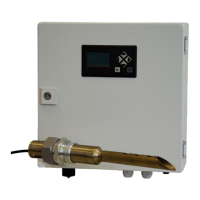53
7 Maintenance
NOTICE
With KS1D HT (item no. 656R2015), the test gas to be tested/calibrated can be connected
directly at the hose connection for calibration gas. A special testing device is not necessary.
The required test gas quantity lies between 40 ... 60 l/h.
Probe calibrated
Test gas matrix for testing or calibrating the respective probe
Test gas composition
Recommendation:
To check the O
2
electrode, use a test gas with 3 vol. % O
2
in N
2
.
NOTICE
It is not possible to calibrate the CO/H
2
electrode using hydrogen free test gas containing CO.
Recommendation:
To check the CO/H
2
, use a test gas with 100 ppm H
2
, 200 ppm CO, and 3 % O
2
in N
2
.
Calibrate to 300 ppm.
For the standard design of the KS1D combination probe, a special testing device is required
(type 650R1015). For calibration adjust the pressure on the pressure gauge between
40 ... 60 mbar.
NOTICE
The pressure gauge is a very sensitive measuring device.
Protect it against overload. Pay attention to the pressure range!
Functional
chrck/calibra-
tion with test
gas
Probe
Probe voltage U-O
2
Probe voltage U-CO probe voltage U-
CO
e
1 Offset A A A
2 OBBB
3 CO/H
2
CCC
Test gas
Composition
O
2
[Vol.%] CO
e
[ppm]
*
* CO Equivalent COe is the sum of all components in the exhaust gas. In test gases, it is represented
by CO and H2 in proportion of 2:1, e.g. 300ppm COe = 200 ppm CO +100 ppm H2.
N
2
[Vol.%]
A
**
** In the test gas device, the probe can be calibrated/tested with oil-free pressure air or synthethic air
from test gas bottle. In a COe-free and defined surrounding, the probe can also be tested/calibrated out-
side of the test gas device.
21 0 Rest
B 3 0 Rest
C 3 300 Rest

